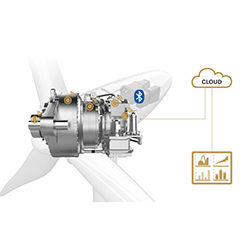Innovative sensor technologies, advanced modelling and new business models are all corner stones in how ZF Wind Power is digitalizing the manufacturing business. For ZF Wind Power digitalization and the Internet of Things (IoT) is an integrated part of this transformation.
For a long time, the wind power industry has been among the front-runners when it comes to connectivity of products and analyzing data in order to optimize products and processes. However, the challenges and benefits have mainly been left to OEMs and turbine owners, with limited feedback to component suppliers.
As the leading transmission supplier in the wind industry, ZF Wind Power is now stepping up the ambition of data insights, taking a leading position on product risk commitments and launching ground-breaking sensing technology used to control speed and drivetrain torque. Thanks to digitalization, ZF connected gearboxes can automatically sense the best way to optimize energy generation and improve turbine economics for any wind site conditions.
A new control strategy with the focus on drivetrain torque
ZF Wind Power, as a business unit of ZF Friedrichshafen AG, has extensive experience of delivering transmissions across industries. More than a decade ago a paradigm shift in drivetrain design for automotive changed how gearboxes were treated.
Instead of designing the gearbox to absorb all the engine torque, a refined control of engine torque was implemented to ensure smooth transmission. Lifetime improved and transmissions have become smoother through the elimination of torque oscillations.
Similarly and based on group-wide learnings, ZF Wind Power is implementing gearbox design standards and operational control strategies to optimize and smooth out torque resulting in more efficient and reliable operation of wind turbines. However, in a wind turbine, the power is less controllable, which forced ZF to develop leading sensing technologies to measure the actual speed and load on the rotor side of the gearbox.
This is because only by knowing the actual speed and load on the main shaft it is possible to manage the matching power of the generator and ensure smooth operation and reap the same benefits as in the case of automotive.






























